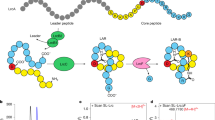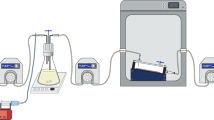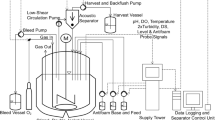Abstract
In the course of our screening for antitrypanosomal compounds from soil microorganisms, as well as from the antibiotics library of the Kitasato Institute for Life Sciences, we found three peptide antibiotics, leucinostatin (A and B), alamethicin I and tsushimycin, which exhibited potent or moderate antitrypanosomal activity. We report here the in vitro and in vivo antitrypanosomal properties and cytotoxicities of leucinostatin A and B, alamethicin I and tsushimycin compared with suramin. We also discuss their possible mode of action. This is the first report of in vitro and in vivo trypanocidal activity of leucinostatin A and B, alamethicin I and tsushimycin.
Similar content being viewed by others
Log in or create a free account to read this content
Gain free access to this article, as well as selected content from this journal and more on nature.com
or
Accession codes
References
Fairlamb, A. H. Chemotherapy of human African trypanosomiasis: current and future prospects. Trends Parasitol. 19, 488–494 (2003).
Matovu, E., Seebeck, T., Enyaru, J. C. K. & Kaminsky, R. Drug resistance in Trypanosoma brucei spp., the causative agents of Sleeping Sickness in man and Nagana in cattle. Microbes Infect. 3, 763–770 (2001).
Brun, R., Schumacher, R., Schmid, C., Kunz, C. & Burri, C. The phenomenon of treatment failures in Human African Trypanosomiasis. Trop. Med. Int. Health 6, 906–914 (2001).
Otoguro, K. et al. Selective and potent in vitro antitrypanosomal activities of 10 microbial metabolites. J. Antibiot. 61, 372–378 (2008).
Ishiyama, A. et al. In vitro and in vivo antitrypanosomal activities of two microbial metabolites, KS-505a and Alazopeptin. J. Antibiot. 61, 627–632 (2008).
Shaw, I. M. & Taylor, A. The chemistry of peptides related to metabolites of Trichoderma spp. 2. An improved method of characterization of peptides of 2-methylalanine. Can. J. Chem. 64, 164–173 (1986).
von Arx, J. A. The genera of fungi sporulating in pure culture. 3rd edn., p. 263, J. Cramer. Vaduz. (1981).
Altschul, S. F., Gish, W., Miller, W., Myers, E. W. & Lipman, D. J. Basic local alignment search tool. J. Mol. Biol. 215, 403–410 (1990).
Otoguro, K. et al. Potent antimalarial activities of the polyether antibiotic, X-206. J. Antibiot. 54, 658–663 (2001).
Mikami, Y. et al. Leucinostatins, peptide mycotoxins produced by Paecilomyces lilacinus and their possible roles in fungal infection. Zbl. Bakt. Hyg. 257, 275–283 (1984).
Arai, T., Mikami, Y., Fukushima, K., Utsumi, T. & Yazawa, K. A new antibiotic, leucinostatin, derived from Penicillium lilacinum. J. Antibiot. 26, 157–161 (1973).
Fukushima, K. & Arai, T. Studies on peptide antibiotics, leucinostatins I. Separation, physico-chemical properties and biological activities of leucinostatin A and B. J. Antibiot. 36, 1606–1612 (1983).
Fukushima, K. & Arai, T. Studies on peptide antibiotics, leucinostatins II. The structures of leucinostatin A and B. J. Antibiot. 36, 1613–1630 (1983).
Pandey, R. C., Cook, Jr J. C. & Rinehart, Jr K. L. High resolution and field desorption mass spectrometry studies and revised structures of alamethicins I and II. J. Am. Chem. Soc. 99, 8469–8483 (1977).
Leitgeb, B., Szekeres, A., Manczinger, L., Vágvölgyi, C. & Kredics, L. The history of alamerhicin: a review of the most extensively studied peptaibol. Chem. Biodivers. 4, 1027–1051 (2007).
Shoji, J., Kozuki, S., Okamoto, S. & Sakazaki, R. Studes on tsushimycin. I. Isolation and characterization of an acidic acylpeptide containing a new fatty acid. J. Antibiot. 21, 439–443 (1968).
Lardy, H., Reed, P. & Lin, C. H. Antibiotic inhibitors of mitochondrial ATP synthesis. Fed. Proc. 34, 1707–1710 (1975).
Reed, P. W. & Lardy, H. A. Uncoupling and specific inhibition of phosphoryl transfer reactions in mitochondria by the antibiotic A20668. J. Biol. Chem. 250, 3704–3708 (1975).
Mori, Y., Suzuki, M., Fukushima, K. & Arai, T. Structure of leucinostatin B, an uncoupler on mitochondria. J. Antibiot. 36, 1084–1086 (1983).
Shima, A., Fukushima, K., Arai, T. & Terada, H. Dual inhibitory effects of the peptide antibiotics leucinostatin in oxidative phosphorylation in mitochondria. Cell Struct. Funct. 15, 53–58 (1990).
Csermely, P. et al. The nonapeptide leucinostatin A acts as s weak ionophore and as an immunosuppressant on T lymphocytes. Biochim. Biophys. Acta. 1221, 125–132 (1994).
Muroi, M. et al. Novel blockade of cell surface expression of virus glycoprotein's by leucinostatin A. J. Antibot. 49, 119–1126 (1996).
Park, J. O. et al. Production of leucinostatins and nematicidal activity of Australian isolates of Paecilomyces lilacinus (Thom) Samson. Lett. Appl. Microbiol. 38, 271–276 (2004).
Kita, K., Nihei, C. & Tomitsuka, E. Parasite mitochondria as drug target: diversity and dynamic change during the life cycle. Curr. Med. Chem. 23, 2535–2548 (2003).
Williams, N., Choi, S. Y., Ruyechan, W. T. & Frank, P. H. The mitochondrial ATP synthase of Trypanosma brucei: Developmental regulation through the life cycle. Arch. Biochem. Biophys. 288, 509–515 (1991).
Brown, S. V., Hosking, O., Li, J. & Wiliams, N. ATP synthase is responsible for maintaining mitochondrial membrane potential in bloodstream form Trypanosoma brucei. Eukaryotic Cell 5, 45–53 (2006).
Ishiguro, K. & Arai, T. Action of the peptide antibiotic Leucinostatin. AAC 9, 893–898 (1976).
Bowles, D. J. & Voorheis, H. P. Release of the surface coat from the plasma membrane of intact bloodstream forms of Trypanosoma brucei requires Ca2+. FEBS Lett. 139, 17–21 (1982).
Ruben, L., Hutchinson, A. & Moehlman, J. Calcium homeostasis in Trypanosoma brucei. J. Biol. Chem. 266, 24351–24358 (1991).
Ruben, L., Akins, C. D., Haghighat, N. G. & Xue, L. Calcium influx in Trypanosoma brucei can be induced by amphiphilic peptides and amines. Mol. Biochem. Parasitol. 81, 191–200 (1996).
Moreno, S. & Docampo, R. Calcium regulation in protozoan parasites. Curr. Opin. Microbiol. 6, 359–364 (2003).
Docampo, R., Souza, W., Miranda, K., Rohloff, P. & Moreno, S. Acidocalcisomes-conserved from bacteria to man. Nat. Rev. Microbiol. 3, 251–261 (2005).
Otoguro, K. et al. In vitro antimalarial activities of microbial metabolites. J. Antibiot. 56, 322–324 (2003).
Meyer, P. & Reusser, F. A polypeptide antibacterial agent isolated from Trichoderma viride. Experientica 23, 85–86 (1967).
Mathew, M. K., Nagaraj, R. & Balaram, P. Alamethicin and synthetic peptide fragments as uncouplers of mitochondrial oxidative phosphorylation. Effect of chain length and charge. BBRC 98, 548–555 (1981).
Irmscher, G. & Jung, G. The hemolytic properties of the membrane modifying peptide antibiotics, alamethicin, suzukacillin and trichotoxin. Eur. J. Biochem. 80, 165–174 (1977).
Mueller, P. & Rudin, D. O. Action potentials induced in biomolecular lipid membranes. Nature 217, 713–719 (1968).
Woolley, G. A. Channel-forming activity of alamethicin: Effects of covalent tethering. Chem. Biodivers. 4, 1323–1337 (2007).
Fonteriz, R. I., López, M. G., Garcia-Sancho, J. & Garca, A. G. Alamethicin channel permeation by Ca2+, Mn2+ and Ni2+ in bovine chromaffin cells. FEBS Lett. 283, 89–92 (1991).
Dathe, M. et al. Proline at position 14 of alamethicin is essential for hemolytic activity, catecholamine secretion from chromaffin cells and enhanced metabolic activity in endothelial cells. Biochim. Biophys. Acta. 1370, 175–183 (1998).
Bunkóczi, G., Vértesy, L. & Sheldric, G. M. Structure of the lipopeptide antibiotic tsushimycin. Acta. Crystallogr. D Biol. Crystallogr. 61, 1160–1164 (2005).
Elbein, A. D. The effect of tsushimycin on the synthesis of lipid-linked saccharides in aorta. Biochem. J. 193, 477–484 (1981).
Packchanian, A. Chemotherapy of African sleeping sickness. II. Chemotherapy of experimental Trypanosoma gambiense and Trypanosoma rhodesiense infections in mice (Mus musculus) with a new antibiotic, amphomycin. Antibiot. Chemother. 6, 684–691 (1956).
Menon, A. K., Mayor, S. & Schwarz, R. T. Biosynthesis of glycosyl-phoshatidylinositol lipids in Trypanosoma brucei: involvement of mannosyl-phosphoryldolichol as the mannose donor. EMBO J. 9, 4249–4258 (1990).
McGwire, B. S., Olson, C. L., Tack, B. F. & Engman, D. M. Killing of African trypanosomes by antimicrobial peptides. JID 188, 146–152 (2003).
Haines, L. R., Hancock, R. & Pearson, T. W. Cationic antimicrobial peptides killing of African trypanosomes and Sodalis glossinidius, a bacterial symbiont of the insect vector of sleeping sickness. Vector Borne Zoonotic Dis. 3, 175–186 (2003).
Gonzalez-Rey, E., Chorny, A. & Delgado, M. VIP: An agent with license to kill infective parasites. Ann. NY Acad. Sci. 1070, 303–308 (2006).
Powers, J. P. & Hancock, R. The relationship between peptide structure and antibacterial activity. Peptides 24, 1681–1691 (2003).
Cerrini, S., Lamba, D., Scatturin, A. & Ughetto, G. The crystal and molecular structure of the alpha-helical nonapeptide antibiotic leucinostatin A. Biopolymers 28, 409–420 (1989).
Ricci, M. et al. Leucinostatin-A loaded nanospheres: characterization and in vivo toxicity and efficacy evaluation. Int. J. Pharm. 275, 61–72 (2004).
Acknowledgements
This work was supported, in part, by funds from the Drugs for Neglected Diseases initiative (DNDi), and a grant for All Kitasato Project Study (AKPS). We are grateful to Dr Y Yabu, the Nagoya City University, Professor R Brun and Dr M Kaiser, the Swiss Tropical Institute, Professor T Kinoshita, the Research Institute for Microbial Diseases, Osaka University and Professor S Croft, Dr Eric Chatelain, Dr J-R Ioset, Dr C Brünger and Miss F Hirabayashi, DNDi, for valuable discussions. We also thank Miss H Sekiguchi, Mr T Furusawa, Miss M Niitsuma and Miss J Hashida (Kitasato university) for her technical assistance throughout this work.
Author information
Authors and Affiliations
Corresponding author
Rights and permissions
About this article
Cite this article
Ishiyama, A., Otoguro, K., Iwatsuki, M. et al. In vitro and in vivo antitrypanosomal activities of three peptide antibiotics: leucinostatin A and B, alamethicin I and tsushimycin. J Antibiot 62, 303–308 (2009). https://doi.org/10.1038/ja.2009.32
Received:
Revised:
Accepted:
Published:
Issue date:
DOI: https://doi.org/10.1038/ja.2009.32
Keywords
This article is cited by
-
In vitro antitrypanosomal activity of the cyclodepsipeptides, cardinalisamides A–C, from the insect pathogenic fungus Cordyceps cardinalis NBRC 103832
The Journal of Antibiotics (2014)
-
In vitro antitrypanosomal activity of five low-MW antibiotics
The Journal of Antibiotics (2012)
-
Panowamycins A and B, new antitrypanosomal isochromans produced by Streptomyces sp. K07-0010
The Journal of Antibiotics (2012)
-
In vitro antitrypanosomal activity of bis(bibenzyls)s and bibenzyls from liverworts against Trypanosoma brucei
Journal of Natural Medicines (2012)
-
In vitro antitrypanosomal activity of some phenolic compounds from propolis and lactones from Fijian Kawa (Piper methysticum)
Journal of Natural Medicines (2012)



